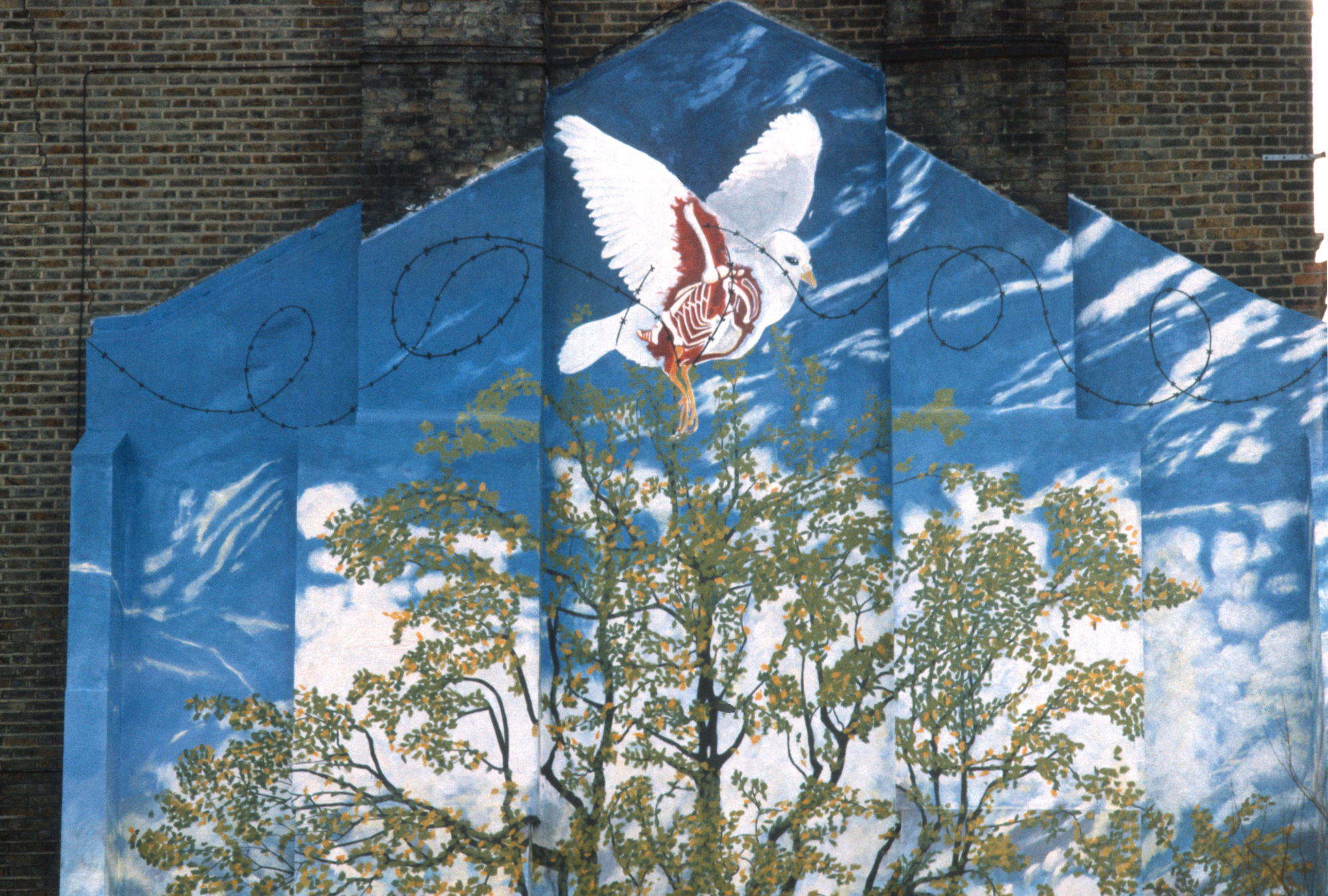Dale worked on four large gable ends. He organised the Vining Street project and designed the ‘Peace’ mural.
Dale was born in Dunedin in New Zealand’s South Island. “It’s an outdoor country” he says; his first memory is of escaping from home aged three, with his twin brother and their pram, to go and play on the beach. He was a lively, confident and adventurous child, did well academically at primary and secondary schools, “a brilliant education system”, where he excelled in drawing and painting, and discovered an enthusiasm for poetry and photography, and was sent to a school for artistic children every weekend.
poetry and photography at school
After leaving school he went to work “on the trucks” before being persuaded to go to Otago University. Here he enjoyed drama, but he found his science course uninteresting and the snobbery of his “educated” peers intolerable and dropped out, then worked at a sawmills and sheep-shearing before getting onto a film course on the North Island, in Wellington.
the first film project
It was 1969, and Dale was successfully working in all aspects of film making – shooting, sound, lighting, editing, music, and writing the commentary. He became the go-to man to rescue films that had gone wrong. After a couple of years he got fed up being tied to the editing suite, and embarked on making short films on his own initiative with a cameraman friend. Finding his freelance initiatives shot down by the Film Unit’s management, he decided that it was time to leave and headed to Sydney, where at ABC Television Studios he progressed from assistant film editor, to Programme Assistant directing the Gardening Programme, and finally “to making seven half-hour film documentaries about Australian artists – a six week turnaround for each one – no introducers – just the artists. Melvyn Bragg should’ve stuck to radio – people want to see the art not talking heads.”
making an artist documentary
After this project he took a six month sabbatical, hanging out in San Francisco, working on futurist urban architecture for Paolo Soleri in the Arizona desert, visiting the Grand Canyon and Mexico. In Los Angeles he discovered street murals “they were sensational, photo-realist. They were coming and going very quickly, getting built over. I thought if film was going to die, then architecture will be the way forward – or murals.” In Canada he discovered that film had indeed given way to television and studios were closing. Soon he was on his way to England, and after a grand tour of the British Isles, came to London and found a place to live in Clapham.
It was here, “someone told me about squatting, and said ‘we have a place for you in Albert Mansions.’ It was a little three-roomed squat, and I just adored it, the most exciting thing I’d ever done, I took to squatting like an angel takes to its wings. I just loved it, it was free, free gas, free electricity, your home and house and a lock on the door. I got some tools and fixed it up and started squatting properly; put on an art exhibition of my drawings and paintings, and then published a newspaper called ‘Squat – the Newspaper God Forgot’ which got circulated around the City. When I was moved on from there I found a squat in a building in Vauxhall and set up ‘Rosetta Cafe’, provisioned with vegetables I collected every day from bins in Nine Elms market.
Then one day I was walking past Thessally Road and there’s a bloke up some scaffolding painting a mural. And there’s a sign, ‘Volunteers wanted to help paint mural’. I says ‘I’m Dale McCrea’ and he says ‘I’m Brian Barnes’ and I says ‘I’ll paint with you.’ And we painted all day every day, pretty much, even in cold weather. And eventually The Seaside Mural was completed and opened.
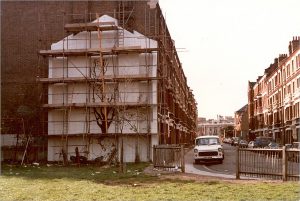 Soon after that I was granted indefinite leave to stay in Britain, and the first day I signed on, I came out of the dole office in Brixton and saw this brilliant wall for a mural on the side of a derelict block of sixteen flats called Carlton Mansions. So I told Brian about it the wall. The problem was, how to get hold of it. Added to that, the building was flooding.” Over the next few days Dale broke in and stopped the flooding.
Soon after that I was granted indefinite leave to stay in Britain, and the first day I signed on, I came out of the dole office in Brixton and saw this brilliant wall for a mural on the side of a derelict block of sixteen flats called Carlton Mansions. So I told Brian about it the wall. The problem was, how to get hold of it. Added to that, the building was flooding.” Over the next few days Dale broke in and stopped the flooding.
Having by this time a reputation for reclaiming and renovating empty properties, he was visited at his latest enterprise – a cafe called ‘Bacteria’ – by people from Housing Emergency Office, affiliated to ‘Shelter’, who negotiated a grant for him to make all the forty-eight rooms Carlton Mansions habitable.
“So off we went. I immediately had a cradle built for me, because I don’t want to worry about planning permission and scaffolding; if I come off the roof then nobody can do anything. So I had these two frames made and bought four winches, and people told me how to work all this stuff and off we went. I stabilised the wall, painted it white, and then Brian says ‘What’s your design?’ Well, I had been commissioned to do a poster for a Squatters Ball, printing it at Brian’s workshop, and had chosen an image by an artist called Fėlicien Rops, which is called ‘Satan Sowing Seeds’ – a figure in clogs with a black hat and a beaky face and he’s strewing bodies over Paris. I copied it off and Brian helped me print it, and then he showed me his design for the mural. He’d used that same figure for what would become for ‘Nuclear Dawn’. I thought the design was brilliant. I squared up my poster and painted the figure on the wall with all the bodies. It worked perfectly. We could just work off that figure. We had such fun. And I kept doing all the flats up. And as that was going on I was being asked to set up another eight housing projects, so I wasn’t so busy as I had been at Thessally Road – there we had been very steady.
funding the murals and locating a site
Around 1982, possibly inspired by ‘Nuclear Dawn’, people began to talk about peace murals for London. There was a meeting at County Hall. I remember writing to Tony Banks and other politicians who were involved, and before you could say Jack Robinson there was forty thousand pounds for distribution between five groups. Well to provide more homes in Brixton, I was already trying to save as many houses as possible from demolition. I remember thinking, if we put murals on a wall in a street already part demolished by the council it would show them we mean business, to try and stop them. I chose Vining Street.”
Pauline Harding: The War Mural
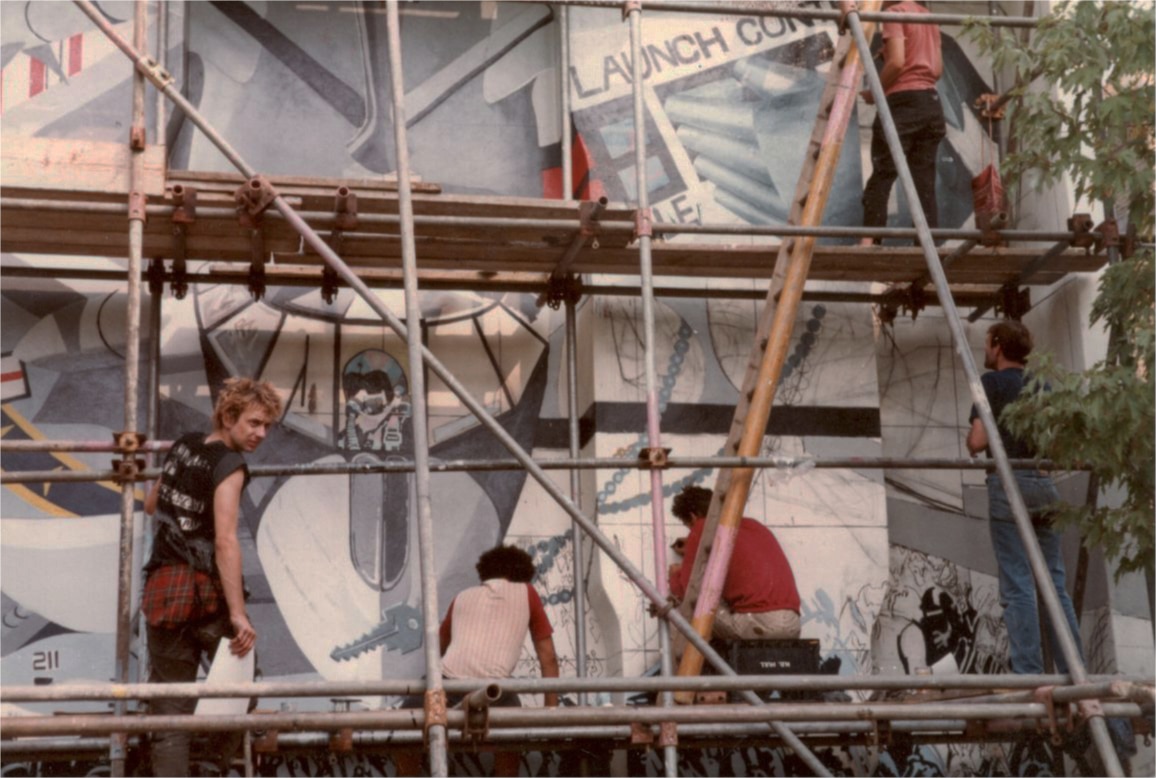
Pauline worked with Youth and Community Groups teaching art and painting murals. She designed the ‘War’ mural.
She was born in 1943 and grew up in Herne Bay in a happy household with three older siblings, first renting, then later in a council house. “Where we lived all the children would play out, on the beach or in the street.” Her father was a tax officer, her mother, born in 1905, was working in a cafe in Brockwell Park in Brixton when they met
“At primary school, I was good at drawing and painting. I was horribly attention seeking, had fun breaking rules, disrupting my uniform, I just felt the need to rebel. I went to a girls’ grammar school, a bit precocious. I loved English, discovered Hemingway when I was fifteen – Spain and the civil war, but it was the relationships that interested me always. About that time saw the film ‘The Horse’s Mouth’ about an artist who paints a mural and thought I want to do that; it’s something that an artist can do that engages beyond working in a gallery.”
cycling in Kent
“I had good friends – there’s always one or two you are close to. In the summer we went riding round Kent on our bicycles, exploring. “We bunked off school to see ‘Rock Around The Clock’. I was not popular with the staff.” At the end of the fifth form Pauline was called to see the head mistress. “She said, ‘Pauline, what do you like?’ I said ‘Art’, ‘Is that your real love?’ ‘I suppose so.’ ‘Well you’d better go to art school them.’ So she chucked me out at sixteen to go to art school in Canterbury.” Her eldest sister had gone to art school before her and had done well. She wrote to her, “Don’t take the painting option for diploma,” so she did just that, with printed textiles in addition. She recalls being taught to draw very accurately, “measuring with the arm’s length pencil and all of that”. Pauline passed her intermediate exam, and in year three a new teacher introduced the students to abstraction.
abstraction and Italy
Pauline failed her National Diploma in Design (NDD), and took a year out in Italy – “a good experience” – before signing on at Wimbledon Art School to take the NDD again. There the studios were excellent and Pauline learned all the skills of printmaking, as well as exploring abstraction, making shaped and spatial forms. “It was great, I liked it, the only trouble was that I was pregnant!” Anton was born in the June at the end of the NDD course. Pauline passed it, and enrolled for teacher training at Goldsmith’s College, where she qualified in 1967. Twice she tried school-teaching but found it too formalised – you’d have a class of children who did not want to be there.”
schools and youth groups
Pauline was receiving benefits, supplemented by working. At first with under-fives, then “It just progressed as Anton grew up, working on adventure playgrounds and finally into youth work. Then I was paid as a tutor, doing three evenings a week. I set up an art room, making paintings, screenprints and crafts like weaving. This is where youth service tutoring worked very well, being with people who wanted to be doing stuff. In the Summer we would paint murals on the foyer, the stairwell and the outside of the Centre.” Years of study and creativity at art school had given Pauline the confidence, skills and understanding to meet a need. “I was inspiring them, giving them confidence to open up, explore and do things – and they were inspiring me.”
“I was beginning to be active in the Campaign for Nuclear Disarmament (CND), joining the Fulham Branch, demonstrating at Greenham Common (Peace Camp) and Faslane, making banners, picketing American bases and going on ‘Cruise Watch’. It was through CND I heard of the ‘Peace Murals Project ‘ and I thought ‘that brings together the art and the peace activism’. So I phoned the regional office and they put me in touch with Dale McCrea. He’d selected an empty space created by bomb damage with a gable wall either end. It was asking to be used. I had a rough design for a ‘wall of weaponry’ – something to be overcome. He said ‘Yes, we can work on that!’
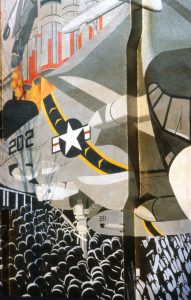 I prepared the wall, primed it. I had heaps of pictures of armaments from CND to develop the design. It became more complicated and fractured in a constructivist way, with many different parts that people could claim for their own to paint – like the pilot in his cockpit or the cruise missiles. One I insisted on painting was ‘Big Boy’, the Hiroshima bomb in the centre, and Dale contributed the bomb factory. At least twelve people painted the mural altogether. It was a great team. Sally, for one, she was there every day and stored the paint at night in her flat. Some contributed more than others but that was alright, everyone contributed what they could. From the initial sketch to completion it took about six months to carry out. There was a mural opening for ‘War’ with the mayor. I went off for a cup of tea and when I got back it had happened, but I shook hands with the leader, Ted Knight. And while ours was going on Dale was thinking about what was going to happen on the facing wall across the open space.”
I prepared the wall, primed it. I had heaps of pictures of armaments from CND to develop the design. It became more complicated and fractured in a constructivist way, with many different parts that people could claim for their own to paint – like the pilot in his cockpit or the cruise missiles. One I insisted on painting was ‘Big Boy’, the Hiroshima bomb in the centre, and Dale contributed the bomb factory. At least twelve people painted the mural altogether. It was a great team. Sally, for one, she was there every day and stored the paint at night in her flat. Some contributed more than others but that was alright, everyone contributed what they could. From the initial sketch to completion it took about six months to carry out. There was a mural opening for ‘War’ with the mayor. I went off for a cup of tea and when I got back it had happened, but I shook hands with the leader, Ted Knight. And while ours was going on Dale was thinking about what was going to happen on the facing wall across the open space.”
Pauline seeing a photo of the ‘Peace’ mural for the first time.
“It is lovely. The colour was very important: we were using primaries and greys and black and white. At the other end it is blues and greens and softish colours.
I carried on working with youth for a while then my life took a different direction. I enrolled for a course in Tai Chi Ch’uan at the Mary Ward Centre. In 1980 my teacher, Master (Sifu) Lam Kam Chuen set up the LAM association and began training teachers of his art. In 1981 I began teaching Tai Chi in adult education centres and colleges. I retired from formal teaching five years ago but still teach a group of experienced students once a week. And of course I am still painting, and exhibiting with the Riverside Artists’ Group.”
preparing for the murals
Dale McCrea: The Peace mural
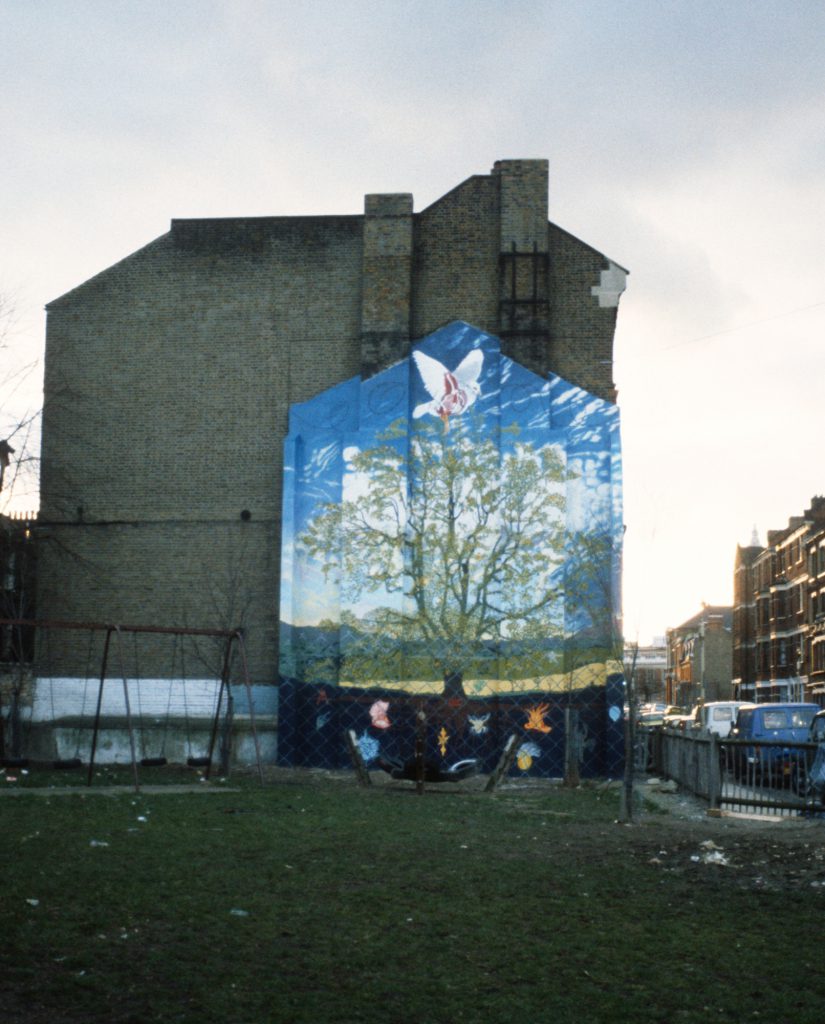 “The design was a of big tree, and on a hillside a white figure, and there were to be signs of the zodiac in the sky; but I decided to substitute that with a dove of peace and some barbed wire; and at the bottom I painted a chain-link fence which refers to the fence at Greenham Common where women had been protesting for a long time. We went out there to see them and their conditions were atrocious, but they were hardy souls and were getting on with it.” The opening of the Peace mural was very funny, with a party and performance artist, and the people in the street appreciated what we were doing.
“The design was a of big tree, and on a hillside a white figure, and there were to be signs of the zodiac in the sky; but I decided to substitute that with a dove of peace and some barbed wire; and at the bottom I painted a chain-link fence which refers to the fence at Greenham Common where women had been protesting for a long time. We went out there to see them and their conditions were atrocious, but they were hardy souls and were getting on with it.” The opening of the Peace mural was very funny, with a party and performance artist, and the people in the street appreciated what we were doing.
Then I got a job as Community Arts Development Officer for the GLC giving out grants for artists and musicians, film-makers, simply responding to requests; and looking at my reports I reckon we spent a million quid in seven months. It was terrific – very enjoyable. After the GLC was suspended I went on to working as Inner City Grants Officer funding playgrounds, printshops, women prisoners’ theatre groups and so on. Eventually I did over-reach myself – over-spent my budget by about three hundred thousand pounds. But that’s another story.”
Dale now lives in Devon.
